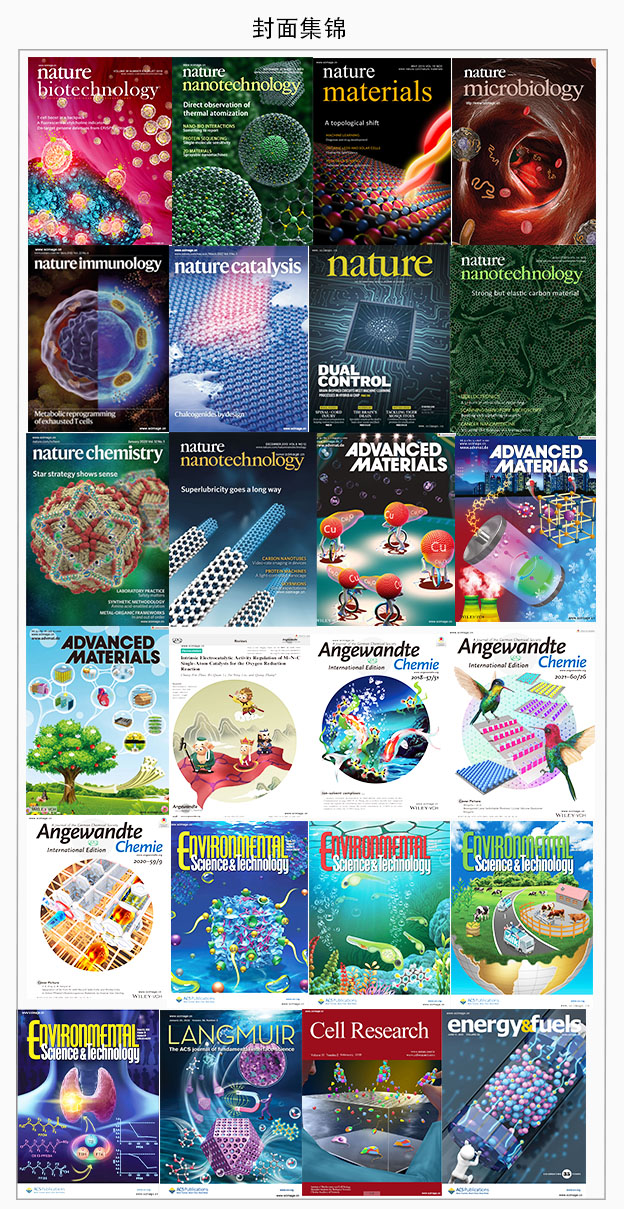博文
2023年6月嘲风作品集(二)
||
▲ Vol 07 Issue 11 | June 07, 2023
Halide perovskites and high-pressure technologies: a fruitful encounter
Fang Xu, Yongtao Zou, Yanmeng Dai, Mu Li and Zeren Li
Recent decades have witnessed significant progress in halide perovskites, a rising star in emerging optoelectronic technology. Their development appeared to have reached a ceiling, and few breakthroughs in novel properties were emerging. But there is an exception: high-pressure techniques, which offer a promising way to synthesize new halide perovskites and change the properties of the existing perovskites. This review article provides an overview of research advances in high-pressure technologies for the development of halide perovskites. It starts with an introduction to apparatus for creating high pressures. Then, the synthesis of halide perovskites is discussed to show the effects of high pressures on their composition, morphology, etc. Then, high-pressure-driven modification of halide perovskites is reviewed, including their crystal structure, bandgap, quantum yield and ionic movement. Although plenty of achievements have been made in this field, challenges still remain, such as exploring new halide perovskites and stabilization of the high-pressure phase under ambient conditions.
https://pubs.rsc.org/en/content/articlelanding/2023/qm/d2qm01257j
▲ Vol 68 Issue 11 | June 15, 2023
SRSF1 is crucial for male meiosis through alternative splicing during homologous pairing and synapsis in mice
Longjie Sun, Juan Chen, Rong Ye, Zheng Lv, Xuexue Chen, Xiaomei Xie, Yuheng Li, Chaofan Wang, Pengbo Lv, Lu Yan, Shuang Tian, Xiaohong Yao, Chen Chen, Sheng Cui, Jiali Liu
Meiotic recombination-related gene (e.g., DMC1, HFM1, MEIOB, MAJIN, C14ORF39/SIX6OS1, STAG3, SYCE1, SYCP2/3, and TERB1/2) mutations have been identified in human subfertility or infertility [1]. Surprisingly, most patients have been found to have aberrant splicing of genes such as MEIOB, C14ORF39/SIX6OS1, STAG3, and SYCE1 [1]. Therefore, it is imperative to understand the mechanism of alternative splicing (AS) and its role in human reproduction to provide new insights for clinical diagnosis [2], [3]. It is well known that testes are rich in AS events [4], [5]. However, the underlying mechanisms of how AS functions in homologous pairing and synapsis are still largely unclear. Our previous research has shown that serine/arginine-rich splicing factor 1 (SRSF1) deficiency impairs primordial follicle formation and leads to primary ovarian insufficiency (POI) [6]. However, the underlying mechanisms by which SRSF1 regulates pre-mRNA splicing during homologous pairing and synapsis of meiotic prophase I in mouse spermatogenesis remain unknown. Here, our work revealed the critical role of an SRSF1-mediated post-transcriptional regulatory mechanism in homologous pairing and synapsis during meiotic prophase I, providing a framework for elucidating the molecular mechanisms underlying the post-transcriptional network of male meiosis.
We first found that SRSF1 expression showed fluctuations during spermatogenesis (Fig. S1 online). To define the specific involvement of SRSF1 in meiosis, we studied the physiological roles of SRSF1 in vivo using a Stra8-GFPCre Srsf1Fl/Fl mouse model (mouse experiments were approved by the Ethics Committee of China Agricultural University (ethical approval No. AW80401202-3-3)) (Fig. S2a–c online) [7], [8]. These data showed that conditional knockout (cKO) of Srsf1 in mouse germ cells impaired meiotic progression and led to non-obstructive azoospermia (NOA) (Fig. 1a, b and S2d–n online). To further evaluate the detailed phenotype, we observed spermatocytes using mouse germ cell surface spreading by co-immunostaining with antibodies against synaptonemal complex protein 3 (SYCP3) and phosphorylated histone H2AX (γH2AX) (Fig. 1c). The data indicated that loss of SRSF1 led to meiotic arrest at the pachytene stage. Meanwhile, we found all chromosomally abnormal synapsis. To further confirm the phenotype, SIX6OS1/C14ORF39, SYCP3, and CREST co-staining was performed during mouse germ cell surface spreading [9]. The data showed that homologous chromosomes were unable to undergo synapsis in cKO spermatocytes (Fig. 1d). In addition, HORMAD1, SYCP3, and CREST co-staining results revealed that all chromosomes failed to undergo synapsis during the pachytene stage (Fig. 1e). Successful homologous pairing relies on initial homology recognition and chromosome movement, and telomere-nuclear envelope attachment (TNEA) is essential for chromosome movement [10], [11]. Thus, intact synaptonemal complex (SC) and TNEA are the keys to synapsis formation [11], [12]. To explore the underlying molecular mechanisms, the expression of SC-related and TNEA-related genes was measured by RT-qPCR. The results showed that the expression of SC-related genes (e.g., Syce1l, Sycp2, Scre, Stag3, Syce2, Tex12, and Smc1b) and TNEA-related genes (e.g., Spdya, Terb1, Kash5, Cdk2, Majin, Terb2, and Sun1) was significantly reduced in cKO STRA8+ cells (Fig. 1f, g). To further explain the abnormal TNEA, transmission electron microscopy was performed on spermatocytes from 14 days post-partum (dpp) mouse testes. The results showed that telomeres were not anchored to the nuclear envelope due to the abnormalities of TNEA (Fig. 1h). To further evaluate this phenotype, TRF1, SYCP3, and Lamin B1 co-staining was performed in 14 dpp mouse testis sections (Fig. 1i). Quantitative results showed a decrease in telomere distribution on the nuclear periphery and an increase in the intra-nuclear domain (Fig. 1j).
https://www.sciencedirect.com/science/article/pii/S2095927323002840
▲ Vol 33 Issue 25 | June 19, 2023
Synergistic Effects of Phase Transition and Electron-Spin Regulation on the Electrocatalysis Performance of Ternary Nitride
Jinjin Ban, Hongjie Xu, Guoqin Cao, Yameng Fan, Wei Kong Pang, Guosheng Shao, Junhua Hu
Phase Transitions
The synergistic effects of phase transition and electron-spin regulation boosts oxygen electrocatalysis. In article number 2300623, Junhua Hu and co-workers, report that a core shell structure of (CoxFe1−x)3N with high dispersibility is induced by an intermediate phase transition process. The moderate eg electron filling (t2g5eg1) in (Co0.17Fe0.83)3N@NPC balances the adsorption of *O2 and the hydrogenation of *OH, improving bifunctional catalytic performances.
https://onlinelibrary.wiley.com/doi/10.1002/adfm.202370156
▲ Vol 57 Issue 24 | June 20, 2023
Redox-Induced In Situ Growth of MnO2 with Rich Oxygen Vacancies over Monolithic Copper Foam for Boosting Toluene Combustion
Qianlin Huang, Puzhen Zhao, Lu Lv, Weiming Zhang, and Bingcai Pan
Catalytic combustion has been known to be an effective technique in volatile organic compound (VOC) abatement. Developing monolithic catalysts with high activity at low temperatures is vital yet challenging in industrial applications. Herein, monolithic MnO2-Ov/CF catalysts were fabricated via the in situ growth of K2CuFe(CN)6 (CuFePBA, a family of metal–organic frames) over copper foam (CF) followed by a redox-etching route. The as-synthesized monolith MnO2-Ov-0.04/CF catalyst displays a superior low-temperature activity (T90% = 215 °C) and robust durability for toluene elimination even in the presence of 5 vol % water. Experimental results reveal that the CuFePBA template not only guides the in situ growth of δ-MnO2 with high loading over CF but also acts as a source of dopant to create more oxygen vacancies and weaken the strength of the Mn–O bond, which considerably improves the oxygen activation ability of δ-MnO2 and consequently boosts the low-temperature catalytic activity of the monolith MnO2-Ov-0.04/CF toward toluene oxidation. In addition, the reaction intermediate and proposed mechanism in the MnO2-Ov-0.04/CF mediated catalytic oxidation process were investigated. This study provides new insights into the development of highly active monolithic catalysts for the low-temperature oxidation of VOCs.
https://pubs.acs.org/doi/10.1021/acs.est.3c02103
<静远嘲风动漫传媒科技中心>设计制作

购书链接:
☆科学的颜值:学术期刊封面故事及图像设计
https://item.jd.com/12802188.html
☆科技绘图/科研论文图/论文配图设计与创作自学手册:CorelDRAW篇
https://item.jd.com/13504674.html
☆科技绘图/科研论文图/论文配图设计与创作自学手册:Maya+PSP篇
https://item.jd.com/13504686.html
☆科技绘图/科研论文图/论文配图设计与创作自学手册:科研动画篇
https://item.jd.com/13048467.html#crumb-wrap
☆SCI图像语法-科技论文配图设计使用技巧
https://item.jd.com/10073529532924.html?bbtf=1


静远嘲风(MY Scimage) 成立于2007年,嘲风取自中国传统文化中龙生九子,子子不同的传说,嘲风为守护屋脊之瑞兽,喜登高望远;静远取自成语“宁静致远”,登高莫忘初心,远观而不可务远。


学习更多绘图教程关注:


https://blog.sciencenet.cn/blog-519111-1400614.html
上一篇:2023年6月嘲风作品集(一)
下一篇:2023年6月嘲风作品集(三)



